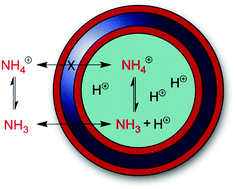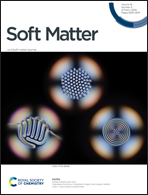Ammonia uptake by transmembrane pH gradient poly(isoprene)-block-poly(ethylene glycol) polymersomes†
Abstract
Transmembrane pH gradient poly(isoprene)-block-poly(ethylene glycol) (PI-b-PEG) polymersomes were investigated for their potential use in the detoxification of ammonia, a metabolite that is excessively present in patients suffering from urea cycle disorders and advanced liver diseases, and which causes neurotoxic effects (e.g., hepatic encephalopathy). Polymers varying in PI and PEG block length were synthesized via nitroxide-mediated polymerization and screened for their ability to self-assemble into polymersomes in aqueous media. Ammonia sequestration by the polymersomes was investigated in vitro. While most vesicular systems were able to capture ammonia in simulated intestinal fluids, uptake was lost in partially dehydrated medium mimicking conditions in the colon. Polymeric crosslinking of residual olefinic bonds in the PI block increased polymersome stability, partially preserving the ammonia capture capacity in the simulated colon environment. These more stable vesicular systems hold promise for the chronic oral treatment of hyperammonemia.



 Please wait while we load your content...
Please wait while we load your content...